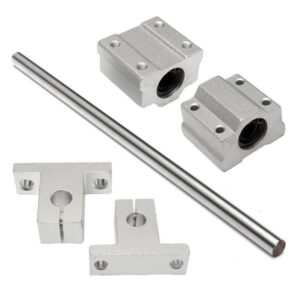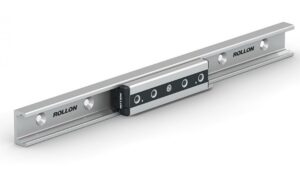Outline for “Linear Bearing and Rail”
| Main Headings | Sub-Headings |
|---|---|
| Introduction to Linear Bearing and Rail | What They Are, Why They Matter in Modern Engineering |
| Linear Bearing and Rail | The Core Concept, How They Work Together |
| Types of Linear Bearings | Ball Bearings, Roller Bearings, Plain Bearings |
| Types of Linear Rails | Profiled Rails, Round Rails, Key Differences |
| Components of Linear Bearing and Rail Systems | Rails, Bearings, Carriages, Rolling Elements, Seals |
| Advantages of Linear Bearing and Rail | Smooth Motion, High Accuracy, Long Lifespan, Energy Efficiency |
| Challenges of Linear Bearing and Rail | Installation Needs, Cost Considerations, Environmental Sensitivity |
| Applications of Linear Bearing and Rail | CNC Machines, Robotics, Aerospace, Healthcare, Semiconductor Industry |
| Installation of Linear Bearing and Rail | Preparation, Mounting, Alignment, Testing |
| Maintenance of Linear Bearing and Rail | Lubrication, Cleaning, Inspection, Wear Detection |
| Common Issues with Linear Bearing and Rail | Noise, Misalignment, Vibration, Contamination |
| Linear Bearing and Rail vs Other Systems | Sliding Guides, Linear Shafts, Comparative Analysis |
| Latest Innovations in Linear Bearing and Rail | Smart Sensors, Advanced Coatings, Lightweight Materials |
| Case Studies in Industry | Automotive Assembly, Precision Robotics, Aerospace Machining |
| Environmental Impact of Linear Bearing and Rail | Energy Efficiency, Recycling, Sustainable Design |
| Choosing the Right Linear Bearing and Rail | Load, Precision, Speed, Budget, Environment |
| Top Global Manufacturers | Hiwin, THK, NSK, Bosch Rexroth, SKF |
| Linear Bearing and Rail in Robotics | Smooth Motion in Automation, Collaborative Robots |
| Linear Bearing and Rail in CNC Machines | Accuracy in Milling, Reduced Vibration, Higher Productivity |
| Linear Bearing and Rail in Healthcare | Medical Imaging, Surgical Robots, Lab Automation |
| Future Trends of Linear Bearing and Rail | AI Integration, Predictive Maintenance, Nano-Coatings |
| Cost and ROI Analysis | Upfront Cost vs Long-Term Savings |
| Safety Considerations | Load Handling, Alignment, Safety Stops |
| Buying Guide for Linear Bearing and Rail | Supplier Reputation, Certifications, After-Sales Service |
| Frequently Asked Questions | Six Clear FAQs with Answers |
| Conclusion | Final Thoughts on Linear Bearing and Rail Systems |
Introduction to Linear Bearing and Rail
Modern engineering relies on precise motion. Behind the smooth movement of robotic arms, CNC machines, and medical devices lies an often-overlooked hero: the linear bearing and rail system.
This duo ensures accurate, low-friction, and repeatable motion. By guiding parts along a straight path, linear bearings and rails provide the backbone of automation. Whether in semiconductor assembly or aerospace manufacturing, their presence is vital to maintain the precision industries demand today.
Linear Bearing and Rail
A linear bearing and rail system consists of two key parts:
The rail: a hardened steel or alloy guideway that provides a smooth pathway.
The bearing: a friction-reducing element that allows the load to glide effortlessly.
Working together, they ensure machines operate with precision, speed, and reliability. Their importance grows in sectors where microns matter, and even the smallest misalignment can cause huge errors.
Types of Linear Bearings
Bearings determine how smoothly the carriage moves along the rail. Common types include:
Ball Bearings
Use recirculating steel balls between the carriage and rail.
Offer high-speed, smooth motion with low friction.
Ideal for robotics and semiconductor equipment.
Roller Bearings
Use cylindrical rollers instead of balls.
Provide more surface contact, offering higher rigidity.
Perfect for heavy-duty CNC machining and aerospace applications.
Plain Bearings
Feature a sliding contact without rolling elements.
Cost-effective and resistant to contaminants.
Better for slower or dirty environments where high precision isn’t critical.
Types of Linear Rails
Rails shape the performance of the system.
Profiled Rails
Have a square or rectangular cross-section.
Provide high stiffness and precision.
Common in CNC machines and high-load applications.
Round Rails
Feature a circular design that simplifies installation.
Less rigid but more forgiving to misalignment.
Used in light to medium-load environments.
Key Differences
Profiled rails excel in rigidity and accuracy, while round rails offer flexibility and ease of use. The right choice depends on whether precision or adaptability is the priority.
Components of Linear Bearing and Rail Systems
A well-designed system includes:
Rails: Hardened tracks for guiding motion.
Bearings: Reduce resistance and carry loads.
Carriages: Hold bearings and support loads.
Rolling Elements: Balls or rollers providing smooth motion.
Seals and Caps: Protect against dust, dirt, and coolant.
Each component plays a critical role in ensuring smooth and reliable operation.
Advantages of Linear Bearing and Rail
The popularity of these systems comes from clear benefits:
Smooth Motion: Rolling elements reduce resistance.
High Accuracy: Precision tolerances ensure repeatable positioning.
Long Lifespan: Even load distribution minimizes wear.
Energy Efficiency: Lower friction reduces power consumption.
Versatility: Suited for light or heavy-duty applications.
Low Maintenance: With proper lubrication, downtime is minimal.
Challenges of Linear Bearing and Rail
No system is perfect. Key challenges include:
Installation Needs: Proper alignment requires skilled technicians.
Cost Considerations: Higher upfront investment than simpler alternatives.
Environmental Sensitivity: Dust and debris can reduce performance if not sealed.
Maintenance Requirements: Though minimal, lubrication and cleaning are non-negotiable.
Despite these issues, the long-term value far outweighs the drawbacks.
Applications of Linear Bearing and Rail
Linear bearings and rails power countless industries:
CNC Machines: Provide rigid, vibration-free precision cutting.
Robotics: Ensure stability and repeatability in automation.
Aerospace: Handle large, heavy components with precision.
Healthcare: Support surgical robots and medical imaging systems.
Semiconductor Industry: Enable high-speed, micrometer-level accuracy.
From heavy industry to delicate surgery, these systems adapt seamlessly.
Installation of Linear Bearing and Rail
Correct installation guarantees performance.
Preparation: Clean rails and mounting surfaces thoroughly.
Mounting: Secure rails to flat, rigid bases.
Alignment: Use precision tools to check parallelism.
Testing: Move carriages along the rail to confirm smooth operation.
Improper installation often leads to premature wear or system failure.
Maintenance of Linear Bearing and Rail
Simple upkeep extends service life.
Lubrication: Apply grease or oil as recommended.
Cleaning: Keep rails free of dust, coolant, or debris.
Inspection: Regularly check for misalignment, noise, or wear.
Wear Detection: Replace seals or bearings when necessary.
Predictive maintenance systems with sensors are increasingly common, especially in high-value industries.
Common Issues with Linear Bearing and Rail
Even robust systems face problems:
Noise: Often caused by lack of lubrication.
Misalignment: Leads to uneven wear and poor accuracy.
Vibration: A result of loose mounting or debris.
Contamination: Dust or coolant entering the system reduces performance.
Most issues can be prevented with proper installation and routine maintenance.
Linear Bearing and Rail vs Other Systems
How do they compare to alternatives?
Sliding Guides: Cheaper but prone to high friction and wear.
Linear Shafts: Simple but less precise for heavy-duty use.
Comparative Analysis: Bearings and rails offer superior accuracy, durability, and ROI.
For industries where performance equals profit, bearings and rails are the clear choice.
Latest Innovations in Linear Bearing and Rail
The field is evolving rapidly:
Smart Sensors: Monitor load, temperature, and vibration.
Advanced Coatings: Anti-corrosion and friction-reducing surfaces.
Lightweight Materials: Aluminum and composites reduce weight without sacrificing strength.
Noise-Reducing Designs: Improve quiet operation in sensitive environments.
These advances make systems smarter, longer-lasting, and more efficient.
Case Studies in Industry
Automotive Assembly: Increased production efficiency by 20% with roller bearings and profiled rails.
Precision Robotics: Achieved micron-level accuracy in semiconductor assembly lines.
Aerospace Machining: Reduced vibration and improved safety in handling jet engine parts.
Real-world use cases prove the transformative power of these systems.
Environmental Impact of Linear Bearing and Rail
Sustainability matters.
Energy Efficiency: Low-friction motion reduces power consumption.
Recycling: Rails and bearings can often be refurbished.
Eco-Friendly Materials: Many companies adopt sustainable alloys and coatings.
These qualities make them compatible with green manufacturing initiatives.
Choosing the Right Linear Bearing and Rail
Selection depends on several factors:
Load Capacity: Heavy loads require roller bearings.
Precision: Ball bearings suit high-speed accuracy needs.
Speed and Acceleration: Consider applications requiring fast movement.
Budget: Balance cost with long-term efficiency.
Environment: Sealed bearings are essential in dusty or wet conditions.
A careful choice ensures reliability and ROI.
Top Global Manufacturers
Trusted names in linear motion include:
Hiwin – Known for affordability and reliability.
THK – Innovators in linear motion technology.
NSK – Focused on durability and precision.
Bosch Rexroth – Leaders in automation systems.
SKF – Specialists in high-performance bearings.
Partnering with reputable brands ensures quality and support.
Linear Bearing and Rail in Robotics
Robots require repeatable precision. Linear bearings and rails allow smooth arm movements, ensuring accuracy in tasks such as welding, assembly, and collaborative operations. In cobots, they enhance safety and consistency.
Linear Bearing and Rail in CNC Machines
CNC machines thrive on stability. These systems reduce vibration, improve tool life, and enable faster machining. The result: higher productivity and consistent finishes.
Linear Bearing and Rail in Healthcare
Healthcare applications demand precision and reliability.
Medical Imaging: Accurate patient positioning.
Surgical Robots: Smooth, controlled movements during delicate procedures.
Lab Automation: Efficient and repeatable sample handling.
These applications highlight the life-saving potential of precision systems.
Future Trends of Linear Bearing and Rail
The future looks promising:
AI Integration: Rails that self-adjust to optimize performance.
Predictive Maintenance: IoT-enabled monitoring for early fault detection.
Nano-Coatings: Frictionless operation at microscopic scales.
These trends will make systems smarter, stronger, and more sustainable.
Cost and ROI Analysis
Though costly upfront, they save money long term.
Upfront Costs: Higher than sliding alternatives.
Operational Savings: Reduced downtime and energy consumption.
ROI: Most companies recoup investment within 1–3 years.
In industries where precision equals profit, the ROI is undeniable.
Safety Considerations
Safe use extends machine and human life.
Load Handling: Always stay within rated capacity.
Alignment Checks: Prevents sudden failures.
Safety Stops: Prevent carriage overruns.
Safety protocols protect workers and equipment alike.
Buying Guide for Linear Bearing and Rail
Before buying, consider:
Supplier Reputation: Choose trusted manufacturers.
Certifications: ISO and CE standards ensure compliance.
After-Sales Service: Access to parts and expertise is essential.
Application Fit: Match bearing type and rail to industry needs.
Smart purchasing decisions ensure long-term value.
Frequently Asked Questions
What is the function of linear bearing and rail?
They provide smooth, low-friction linear motion for precision applications.
Which is better: ball bearing or roller bearing?
Ball bearings are smoother and faster, while roller bearings handle heavier loads.
Do they require lubrication?
Yes. Regular lubrication prevents wear and ensures smooth performance.
Can linear bearings and rails be used vertically?
Yes, they’re designed to handle loads in multiple directions.
Are they expensive?
Upfront costs are high, but long-term savings justify the investment.
How long do they last?
With proper care, they can last years, often exceeding 10,000 km of travel.
Conclusion
The linear bearing and rail system is the unsung hero of precision engineering. By ensuring smooth, accurate, and reliable motion, it powers industries from robotics to healthcare.
Though more costly upfront, its long lifespan, energy efficiency, and precision make it a worthwhile investment. With ongoing innovations—like AI integration and advanced coatings—the future of linear motion systems looks brighter than ever.
For any industry where accuracy matters, linear bearings and rails aren’t just components; they are essential partners in success.
Inbound Link Suggestions
Article on Linear Motion Rails for deeper comparisons.
Post on Roll Rail for alternative system insights.
Outbound Link Suggestions




